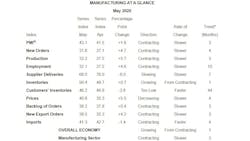ISM: Manufacturing executives cautiously optimistic 3 months into pandemic disruptions
Economic activity in the manufacturing sector contracted in May, and the overall economy returned to expansion after one month of contraction, say the nation’s supply executives in the latest Manufacturing ISM Report On Business.
The May PMI registered 43.1%, up 1.6 percentage points from the April reading of 41.5%. This figure indicates expansion in the overall economy after April's contraction, which ended a period of 131 consecutive months of growth.
“Three months into the manufacturing disruption caused by the coronavirus (COVID-19) pandemic, comments from the panel were cautious (two cautious comments for every one optimistic comment) regarding the near-term outlook,” said Timothy R Fiore, chair of the ISM Business Survey. “As was the case in April, the PMI indicates a level of manufacturing-sector contraction not seen since April 2009; however, the trajectory improved.
“Demand contracted heavily again, with the New Orders contracting at a strong level, again pushed by New Export Orders contraction; both indexes contracted at slower rates, Customers’ Inventories Index returning to a level considered a positive for future production, and Backlog of Orders Index remaining in strong contraction territory, in spite of weak production during the period. Consumption (measured by the Production and Employment indexes) contributed positively (a combined 10.3-percentage point increase) to the PMI calculation, with many panelists classified as non-essential beginning to return to work in late May.”
Other highlights from the report:
- The New Orders Index registered 31.8%, compared to the April reading of 27.1%.
- The Production Index registered 33.2%, compared to the April reading of 27.5 %t.
- The Backlog of Orders Index registered 38.2%, compared to the April reading of 37.8%.
- The Employment Index registered 32.1%, compared to the April reading of 27.5%.
- The Supplier Deliveries Index registered 68%, compared to the April figure of 76%, which elevated the composite PMI.
- The Inventories Index registered 50.4%, compared to the April reading of 49.7%.
- The Prices Index registered 40.8%, compared to the April reading of 35.3 %.
- The New Export Orders Index registered 39.5%, compared to the April reading of 35.3%.
- The Imports Index registered 41.3%, compared to the April reading of 42.7%.
“Inputs—expressed as supplier deliveries, inventories and imports—strengthened again due to supplier delivery issues that were partially offset by continuing imports sluggishness,” Fiore said.
“The delivery issues were the result of disruptions in domestic and global supply chains, driven primarily by supplier plant shutdowns. Inventory expanded due to issues with throughput and demand weakness. Inputs contributed negatively (a combined 7.3-percentage point decrease) to the PMI calculation. (The Supplier Deliveries and Inventories indexes directly factor into the PMI; the Imports Index does not.) Prices continued to contract (but at a slower rate in May), supporting a negative outlook.”
Primary metals, transportation equipment, fabricated metal products, machinery and miscellaneous manufacturing were among 11 industries reporting contraction in May. Only six of the 18 manufacturing industries reported growth.
“The coronavirus pandemic impacted all manufacturing sectors for the third straight month,” Fiore maintained. “May appears to be a transition month, as many panelists and their suppliers returned to work late in the month.
“However, demand remains uncertain, likely impacting inventories, customer inventories, employment, imports and backlog of orders. Among the six biggest industry sectors, Food, Beverage & Tobacco Products remains the only industry in expansion. Transportation Equipment; Petroleum & Coal Products; and Fabricated Metal Products continue to contract at strong levels.”
Here are some selected comments from respondents:
- “Despite the COVID-19 issues, we are seeing an increase of quoting activity. This has not turned into orders yet, but it is a positive sign.” (Computer & Electronic Products)
- “Current conditions in the automotive, construction, oil and gas, agriculture equipment, and tube/pipe markets are all adversely impacting our business results.” (Chemical Products)
- “We see an issue with suppliers that are affecting production. At the same time, social distancing measures in [the] manufacturing plant and customer demand are impacting the rate of production.” (Transportation Equipment)
- “Increased COVID-19 sales in the food business has really stressed our production capabilities.” (Food, Beverage & Tobacco Products)
- “Fuel sales demand are beginning to rebound in May as stay-at-home orders are lifted across the country.” (Petroleum & Coal Products)
- “Returning to full production for automotive, ramp-up will still depend on speed of automotive start-ups. We have built up inventory to stock. Ready to ship.” (Fabricated Metal Products)
- “Business activity remains strong for consumable applications and very weak in durable segments.” (Plastics & Rubber Products)
- “We have been fortunate that most of our customer base is considered to be a part of the critical workforce, so we have been running at around 80% of our normal production volume.” (Primary Metals)
- “Getting out from under several suppliers being closed worldwide. Also, looking at what really needs to be in China.” (Machinery)
- “We see a lot of positive signs, despite what's going on. People seem to continue to be building and looking to projects for fall of 2020 and beyond. There is good optimism out there.” (Nonmetallic Mineral Products)

